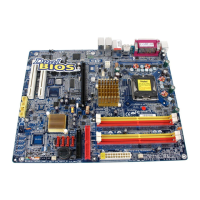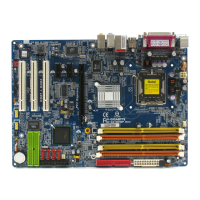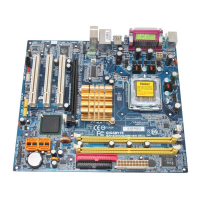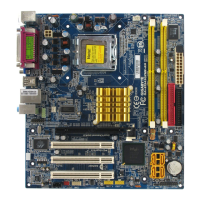
Do you have a question about the Gigabyte GA-8I915P Dual Graphic and is the answer not in the manual?
| Form Factor | ATX |
|---|---|
| Chipset | Intel 915P |
| CPU Socket | LGA 775 |
| Max Memory | 4 GB |
| Memory Type | DDR |
| USB Ports | 8 x USB 2.0 |
| Front Side Bus | 800/533 MHz |
| SATA | 4 x SATA 1.5Gb/s |
| LAN Chipset | Realtek RTL8110S |
| LAN Speed | 10/100/1000 Mbps |
| Supported CPUs | Intel Pentium 4 / Celeron D |
| Memory Slots | 4 |
| Expansion Slots | 3 x PCI |
| Storage Interfaces | 4 x SATA |
| Audio | Realtek ALC880 |
| PS/2 | 2 |
Essential pre-installation steps, safety, and warranty exclusion.
Overview of CPU, Chipset, Memory, Slots, and Peripherals.
Detailed steps for installing CPU and heatsink with safety notes.
Guide to installing DDR II & DDR memory modules with diagrams.
Steps to install expansion cards, including PCI Express x16.
Guide to setting up multiple monitors using Dual Graphic technology.
Explanation of connectors on the back panel (PS/2, USB, LAN, etc.).
Overview of various motherboard connectors and their functions.
Information about ATX power connectors and pin assignments.
Details on connecting CPU, System, and Power fan connectors.
Information on connecting the Northbridge fan connector.
Connecting Floppy and IDE devices, including jumper settings.
Details on Serial ATA and power indicator LED connectors.
Pin assignments for front panel connectors (power, reset, LEDs).
Connecting audio panels and CD audio input.
Connecting front USB and IEEE 1394 ports, including polarity.
Connecting IR connector and clearing CMOS via jumper.
Battery replacement, CMOS clearing, and Dual Graphic dip switch settings.
Key commands for navigating and operating the BIOS setup utility.
Overview of the main BIOS setup menu options.
BIOS settings for date, time, and IDE devices.
BIOS settings for boot priority, CPU features, and display init.
BIOS settings for onboard peripherals like IDE, SATA, USB, LAN.
BIOS settings for ACPI, wake-up events, and power control.
BIOS settings for Plug and Play and PCI IRQ assignments.
Monitoring system voltages, temperatures, and fan speeds.
BIOS settings for CPU clock, ratios, voltages, and memory.
Loads BIOS settings for system stability.
Loads BIOS settings for best performance.
Setting supervisor and user passwords for BIOS access.
Saving BIOS configuration and exiting the setup utility.
Exiting BIOS setup without saving changes.
Configuration of system date, time, IDE channels, and floppy drives.
BIOS settings for boot priority, CPU features, and display init.
BIOS settings for onboard IDE, SATA, USB, LAN, and audio.
BIOS settings for ACPI suspend types and wake-up events.
BIOS settings for PCI IRQ assignments.
Monitoring system voltages, temperatures, and fan speeds.
BIOS settings for CPU clock, ratios, voltages, and memory.
Loads BIOS settings for system stability.
Loads BIOS settings for best performance.
Setting supervisor and user passwords for BIOS access.
Saving BIOS configuration and exiting the setup utility.
Exiting BIOS setup without saving changes.
Instructions for installing chipset INF files and UAA Bus driver.
Overview of Gigabyte utilities like EasyTune 5, DMI Viewer, @BIOS.
Lists contents of software and drivers on the CD.
Lists all hardware devices installed on the motherboard.
Information on how to contact Gigabyte support.
Overview of Gigabyte's unique software utilities.
Introduction to the EasyTune 5 utility for system enhancement.
Introduction to Xpress Recovery for system backup and restore.
Introduction to Dual BIOS technology and Q-Flash utility.
Guide for updating BIOS with Q-Flash on single-BIOS motherboards.
Explanation of RAID levels (RAID 0, RAID 1) and setup.
Guide to configuring 2/4/5.1/7.1 channel audio output modes.











